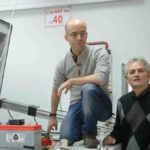
December 19, 2016
What combinations of mutations help cancer cells survive? Which cells in the brain are involved in the onset of Alzheimer’s? How do immune cells conduct their convoluted decision-making processes? Researchers at the Weizmann Institute of Science have now combined two powerful research tools – CRISPR gene editing and single cell genomic profiling – in a method that may finally help us get answers to these questions and many more.
The new technology enables researchers to manipulate gene functions within single cells, and understand the results of each change in extremely high resolution.
According to the Weizmann researchers, a single experiment with this method may be equal to thousands of experiments conducted using previous approaches, and it may advance the field of genetic engineering for medical applications.
The gene-editing technique CRISPR is already transforming biology research around the world, and its clinical use in humans is just around the corner. CRISPR was first discovered in bacteria as a primitive acquired immune system, which cuts and pastes viral DNA into their own genomes to fight viruses. In recent years, this bacterial system has been adopted by researchers to snip out or insert nearly any gene in any organism or cell, quickly and efficiently.
“But CRISPR on its own, is a blunt research tool, since we often have trouble observing or understanding the outcome of this genomic editing,” said Professor Ido Amit of the Weizmann Institute of Science’s Immunology Department, who led the study.
“Most studies so far have looked for black-or-white types of effects but the majority of processes in the body are complex and even chaotic,” added Dr Diego Jaitin of Amit’s lab group.
Professor Amit and his lab team have been developing the second arm of the new method – single-cell RNA sequencing, a rapidly advancing field that is making an impact on many areas of research and biotechnology. By sequencing the messenger RNA molecules in each individual cell – messages that indicate cellular activity – the researchers are able to uncover the molecular makeup of each cell, and to discern a nuanced range of cell identities and functions in a given cell population.
“It is a new molecular microscope,” said Professor Amit.
Thousands of cells from a particular tissue in the body can be sequenced at once in his lab, uncovering variation in cell identities and functions. This method has been used to understand everything from the effects of fetal brain development, to how common immune cells function differently in the various tissues of our body, including their involvement in cancer or neurodegeneration. But single-cell sequencing has mostly been an observatory tool, providing a snapshot of a given tissue sample.
Combing CRISPR with the fine resolution of single-cell RNA sequencing can enable researchers to actively tinker with the genes in cells, and then to understand their functions within numerous cell types in a variety of situations.
The challenge for Amit and his group, including lead authors Drs Jaitin, Ido Yofe and Assaf Weiner, and research student David Lara-Astiaso, was to adapt the CRISPR gene editing technology so it could be used in combination with single-cell sequencing.
The group envisioned targeting many genes at once, including combined targets in the same cell, and then identified the resulting changes to the cell and its function. This undertaking required, the development of new molecular techniques for simultaneously identifying targeted cells and the genome edits introduced to them, and the development of new computational methods for analyzing a community of cells with different genotypes and phenotypes.
The researchers then faced a new type of data – with quite a few missing values.
“By linking cells with similar behaviours, something like the algorithms Netflix uses to group people who like similar movies, we were able to identify previously unrated function for many genes,” said Dr Weiner, who developed the algorithms to analyze the data.
The combined method enabled the research team to ‘probe the wiring’ of particular mouse immune cells as they combat pathogens. This ‘proof of principle’ experiment identified genes that are important for the function of various immune cells, and illustrated in high resolution how they direct a complex and concentrated response against invading pathogens.
Combining the two methods can provide new insight that neither method alone would be able to yield.
“The results can be observed in a resolution never before achieved for this type of study, and these can be obtained more easily and in a fraction of the time,” said Dr Yofe.
The versatility of the method, combined with the precision the team developed by refining their design through experimentation, suggest that it can be used in the future to investigate many open questions, and produce new results that no one can yet predict.
The results of the research in Professor Amit’s lab were published today in Cell, along with descriptions of two similar technologies developed at the Broad Institute in Boston and the University the California, San Francisco.
“The advent of CRISPR presented a true leap in the ability to understand and start editing immune circuits. We are hoping that our approach will be the next leap forward, providing, among other things, the ability to engineer immune cells for immunotherapy,” ” said Professor Amit.
Profossor Ido Amit’s research is supported by the Benoziyo Endowment Fund for the Advancement of Science; the David and Fela Shapell Family Foundation INCPM Fund for Preclinical Studies; the Leona M. and Harry B. Helmsley Charitable Trust; the Rosenwasser Fund for Biomedical Research; the Alan and Laraine Fischer Foundation; Isa Lior, Israel; Drs Herbert and Esther Hecht, Beverly Hills, CA; the Comisaroff Family Trust; Rising Tide; the David M. Polen Charitable Trust; the BLG Trust; and Mr and Mrs Harold Hirshberg, Park Ridge, NJ. Prof. Amit is the recipient of the Helen and Martin Kimmel Award for Innovative Investigation.

Professor Ido Amit






